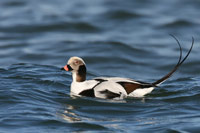European Seaduck Populations in Steep Decline
 Bonn
Bonn
/ Slimbridge, 1 December 2011 - “The conservation
status of seaduck populations in north and west European
waters is of rapidly increasing concern,” warn
two senior experts from the United Kingdom and Denmark
in a recently published “Overview of the status
of European seaducks and actions required for their conservation”.
According to the note, monitoring data indicates that
many seaduck populations are now in steep decline,
with little information available on the demographic
explanation for this, or the likely environmental causes.
Recent coordinated surveys from the Baltic Sea1
(the key wintering area for most seaduck species) indicate
that most seaduck species there are currently experiencing
significant declines. For example, Long-tailed Duck
has declined by as much as 65% since the previous coordinated
survey in 1992-93.
The two duck researchers say, declines in seaduck numbers
have also been noted within other parts of Europe,
as well as in North America.
Whilst the basic trends appear clear, knowledge is
currently lacking on the possible causes of these observed
declines and how they impact seaducks demographically.
Clearly, a number of potential threats exist (e.g.
by-catch in fishing nets, reductions in nutrient loads,
over-harvesting or small oil spills and other forms
of pollution), but the effect of these factors on seaduck
abundance is poorly understood.
“There is an urgent need to diagnose the causes
of the observed declines, and improve our knowledge
of the
status of these populations, and the threats they face.” said
Richard Hearn, from the Wildfowl & Wetlands Trust
and the IUCN-SSC/WI Duck Specialist Group, who is one
of the authors of the overview. “A conservation
planning workshop is urgently needed to take this process
forwards in a coordinated and effective manner, and
it is essential this is carried out at a population
(flyway) scale, which will require international cooperation.” underlines
Hearn.
“A clear framework and an internationally agreed
way forward to address seaduck conservation in Europe
is urgently needed if the rapid declines of many of
these seaducks are to be halted” says Hearn, “Such
an approach is also required in order to meet international
conservation obligations, such as those set out in
the EU Birds Directive, the African-Eurasian Waterbird
Agreement (AEWA) and the Aichi global biodiversity
targets.” says Hearn.
To read the full “Overview of the status of
European seaducks and actions required for their conservation” please
click here.
The overview was prepared and submitted
to the UNEP/AEWA Secretariat by:
Richard Hearn, IUCN-SSC/WI Duck Specialist Group, c/o
Wildfowl & Wetlands
Trust, Slimbridge, Glos. GL2 7BT, United Kingdom: Richard.Hearn@wwt.org.uk and
Henrik Skov, Senior Ecologist, DHI, Agern Allé 5,
DK-2970 Hørsholm, Denmark: hsk@dhigroup.com
___________________________
Further information:
- WWT news release: Thousands
of seaducks go missing - Overview of the status of
European seaducks and actions required for their conservation - BirdLife International: Baltic seaduck take a dive
Last updated on 16 June 2014


